Located on a well-watered plain just 13 miles from the Kazakh-Uzbek border is the beautiful city of Tashkent. This ancient city is the capital and largest city in Uzbekistan. It’s also the most populous city in the Central Asian countries that made up the Soviet Union. But despite being one of Central Asia’s greatest metropolises, Tashkent, and Uzbekistan as a whole, still escapes most travelers’ radar. But I’m here to tell you that there are numerous things you must see and do in Tashkent.

At 2,200 years old, Tashkent may not be quite as ancient as other cities in Uzbekistan. Khiva, Bukhara, and Samarkand may be older, but Tashkent’s rich history is undeniable. In its pre-Islamic days, Tashkent was known by the name Chach. It dated back to at least the 5th century BC.

The city was famously destroyed by Genghis Khan and the Mongols in 1219. It was then rebuilt during the Timurid and Shaybanid Empires that followed. Meanwhile, Tashkent’s location along the Silk Road caused the city to flourish. Merchants, traders, and explorers from the East and West passed through the city, influencing its food, culture, and religion.

During the 18th and 19th centuries, Tashkent became an independent city-state before falling to the Russian Empire in 1865. It was named the capital of Russian Turkestan and later became part of the Soviet Union in 1925. After much of its Old City was destroyed in a 1966 earthquake, Tashkent was rebuilt again, this time in the Soviet style. And although the Soviet Union fell in 1991, relics from that era—namely its wide streets, apartment blocks, plazas, and statues to figures like Lenin—are still prominently featured around the city to this day.
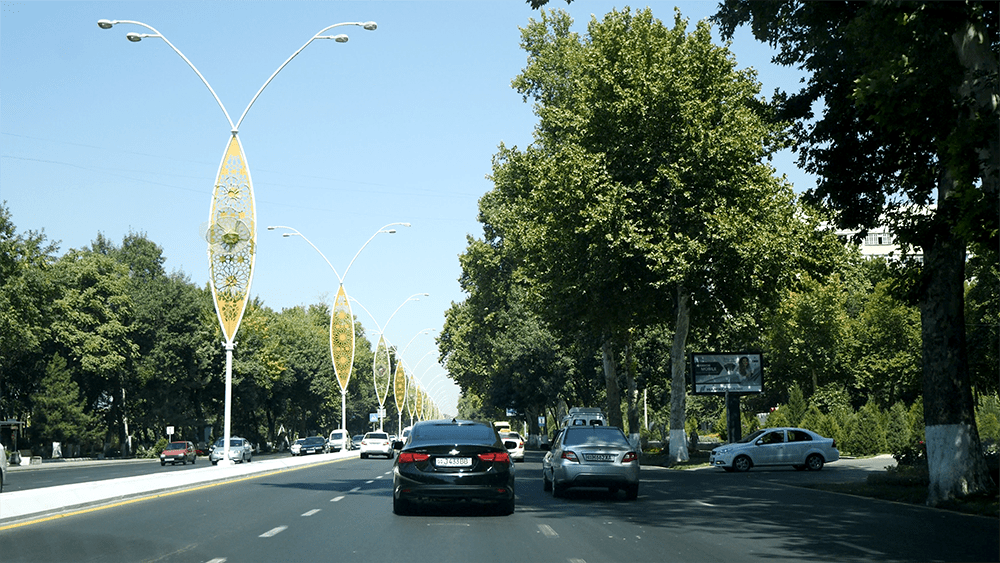
Today, Tashkent is the most modern city in Uzbekistan. It’s also very well-connected, thanks in part to its international airport, roads, and subway system. It’s also a fantastic food city, with no shortage of places to try some of Uzbekistan’s most delicious traditional foods. And while most of Tashkent’s ancient, historical buildings are no more, you’ll still find a few gems as you explore the city. These are the 15 things you must see and do in Tashkent, Uzbekistan.

One of my favorite aspects of traveling to a new destination is trying the local cuisine. Almost immediately upon arriving in Tashkent, I set out on my very first Uzbek adventure: trying a somsa. Somsas are savory pastries filled with meat and onions. They can be found all over Central Asia with minor spelling and pronunciation differences, but they’re essentially the same. The best spot in Tashkent to try them is Minor Somsa Restaurant.
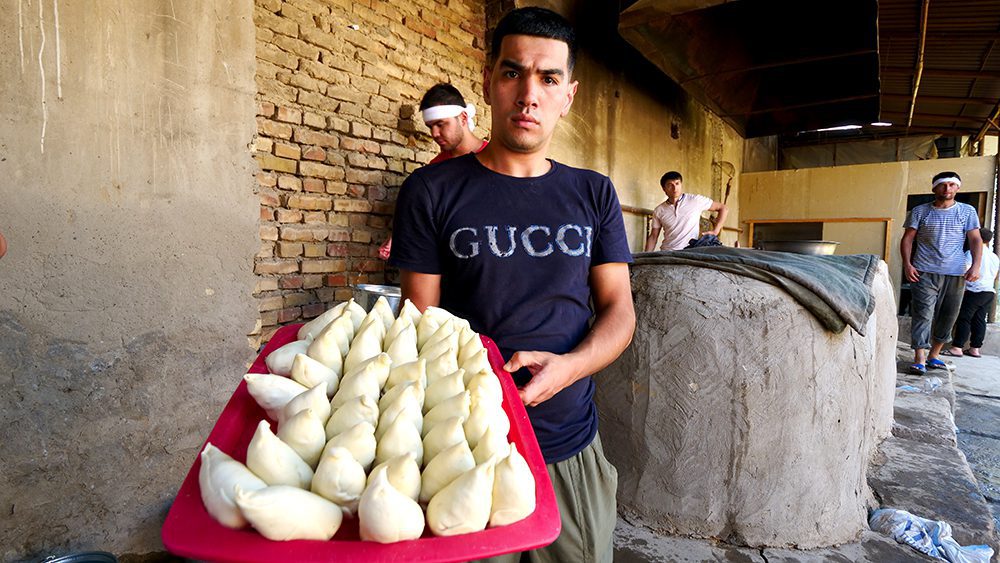
While similar meat pastries like Latin American empanadas and Indian samosas are always fried, somsas are always baked. They’re cooked by sticking the uncooked beef somsas to the inside wall of a large, clay oven called a tandoor.
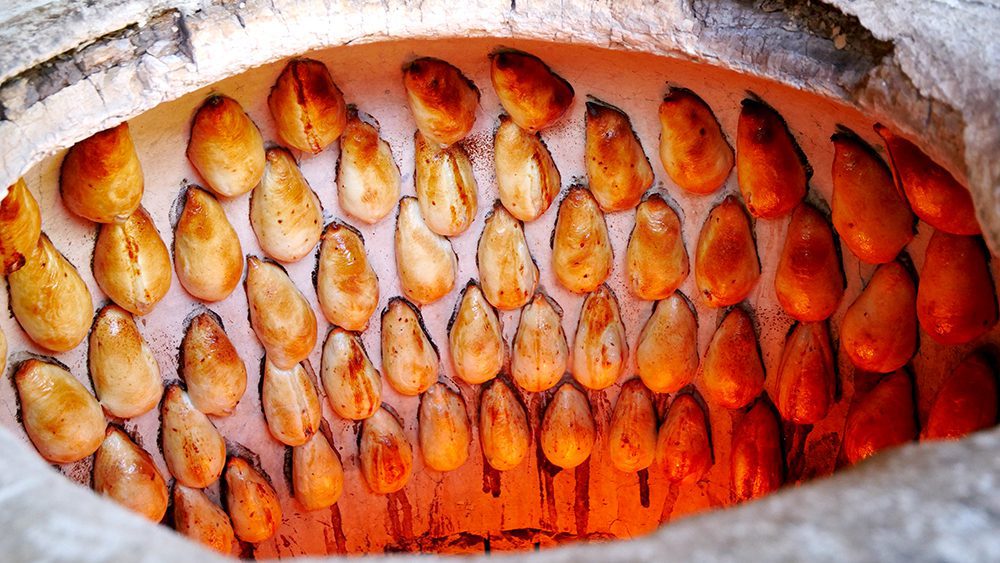
Minor Somsa Restaurant is an open-air restaurant with an outdoor terrace. They have four tandoor ovens outside, which they fire up and toss water inside. The ovens get to about 300 degrees inside, so the cooks use a special tool to scrape the somsas off the interior wall.

Minor Somsa Restaurant was packed with locals the day I visited, and after one bite of my first somsa, I could see why. They were unreal! The minced beef inside was tender and juicy. The meat was full of flavorful spices that made my mouth water, while the onions inside added a nice, acidic crunch.
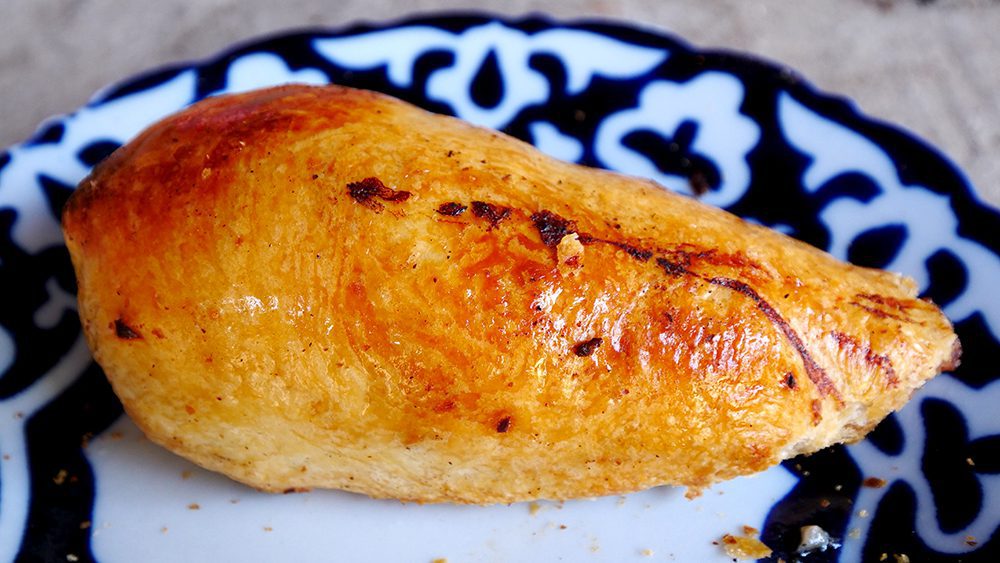
Because the somsas were baked, the dough was crispy and flaky on the outside and still soft on the inside. For an added flavor kick, try them with some tomato sauce. Best of all, the somsas are ridiculously affordable at only $0.30 USD each!

While in Uzbekistan, I recommend always having some local green tea with your meals. It’s called Mountain Tea, which is said to be healthier than other types of tea. The mountain tea has a light flavor but is still quite tasty. And while it was very good, I had other reasons for drinking it. The dry, desert air in Tashkent had made me hoarse, and I had started losing my voice. The tea helped soothe my dry, scratchy throat so I could continue documenting my experience for my YouTube show!

Eating incredible food like this is always an experience. It’s why dining at Minor Somsa Restaurant is one of the top things to see and do in Tashkent, Uzbekistan!
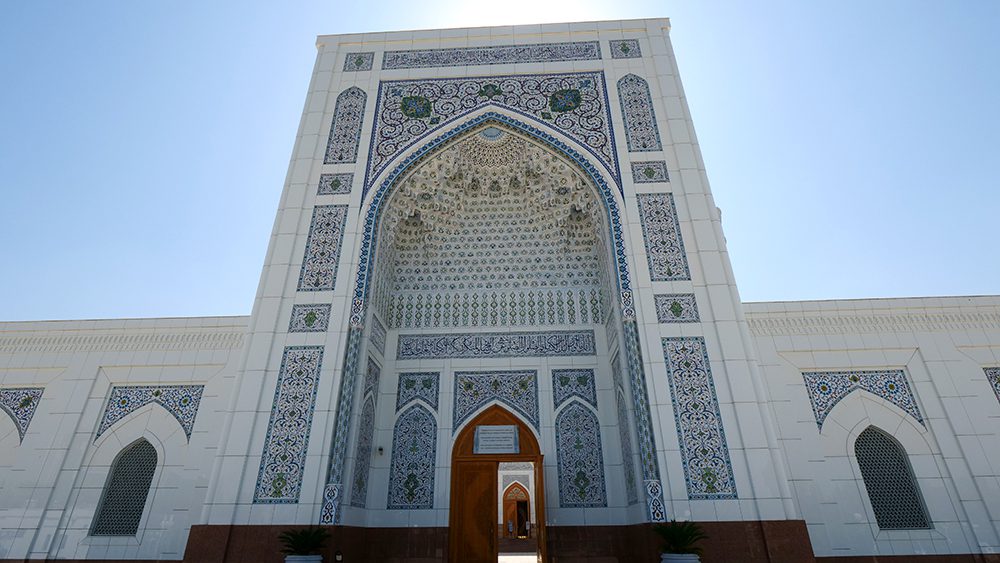
While many people might think Islamic architecture in Uzbekistan is a thing of the past in the post-Soviet era, Minor Mosque is proof that it’s still alive and well. This gorgeous mosque made of white marble was only 4-5 years old when I visited in August of 2019. Despite its youth, it has become the main mosque in city.
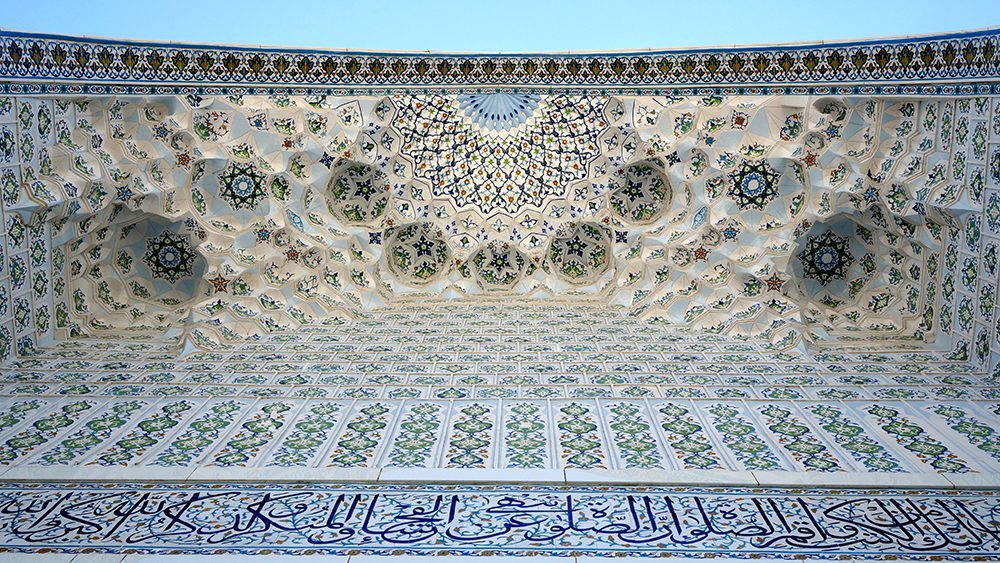
The architecture at Minor Mosque is breathtaking. The outside of the gleaming, white building is adorned with stunning, hand-painted tiles. As my exploration around Uzbekistan continued over the next week and a half, I would learn that blue tiles are a fixture in the architecture around the country.
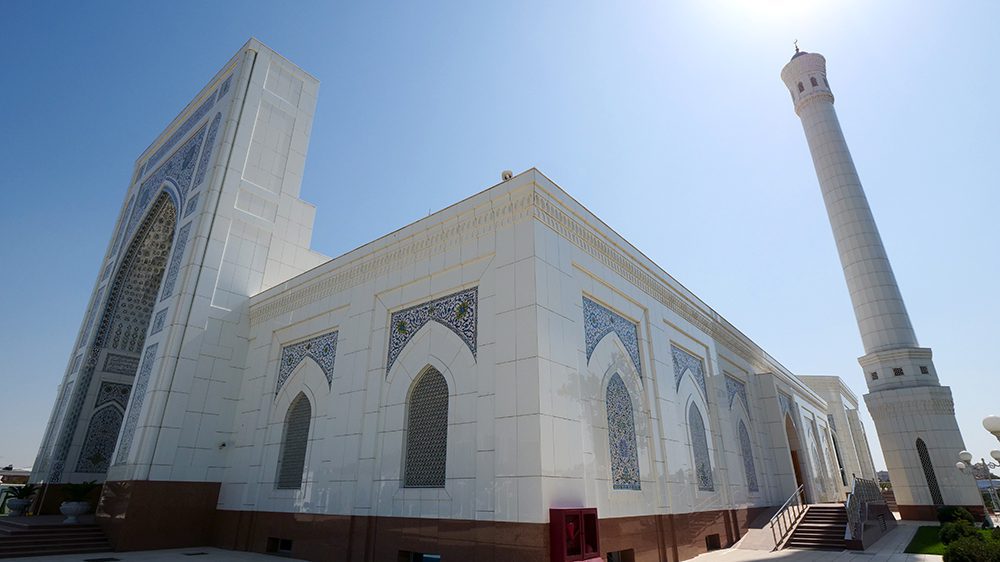
A pair of minarets stand proudly on either side of the mosque. Visitors will also find a pair of beautiful, hand-crafted doors with intricate designs on them. There’s also a fountain and a circular prayer hall with an equally gorgeous mihrab, which faces Mecca. It’s an incredible site and seeing it is one of the best things to see and do in Tashkent!
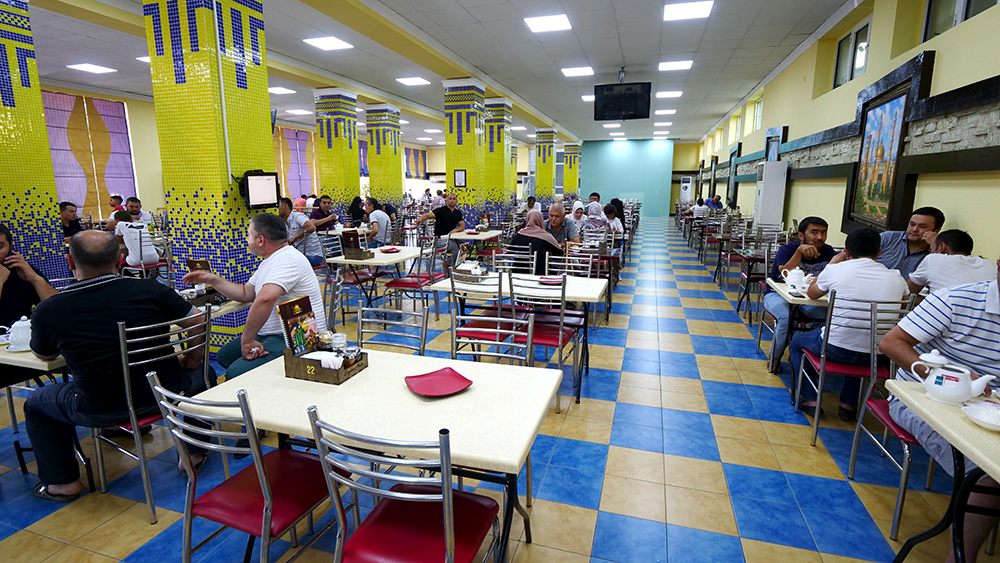
As I mentioned earlier, the traders, merchants, and explorers who passed through Tashkent via the Silk Road helped influence its culture. Among those travelers were people from both China and India. The travelers from those countries helped shape Uzbek cuisine, and their influences can be tasted at our next restaurant, Lagman House.
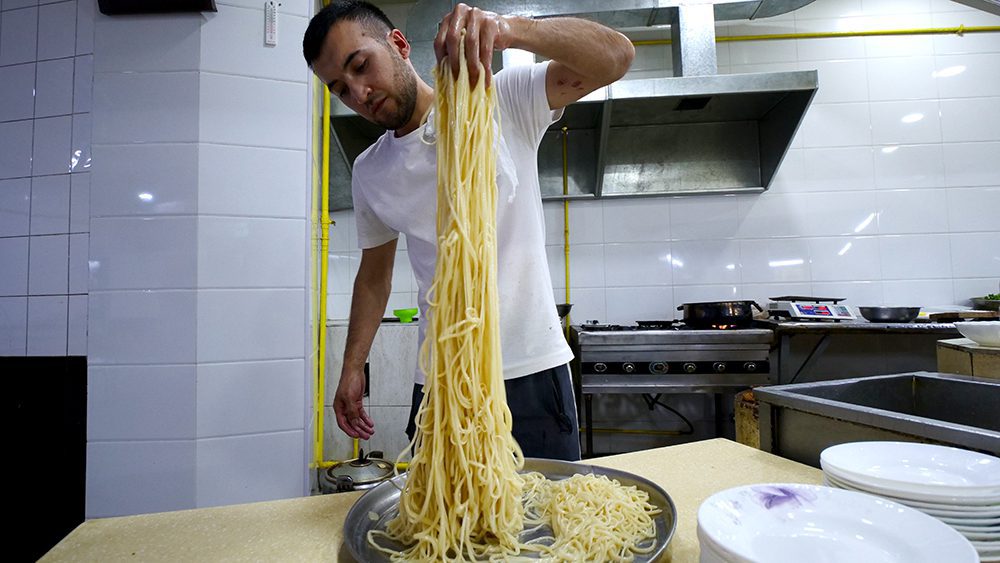
Eating Lagman House is one of the top things to see and do in Tashkent for their signature dish, lagman. This enticing Central Asian dish consists of pulled noodles, meat, vegetables, and sauce. The noodles are thickly cut and al dente, exactly the way I like them.
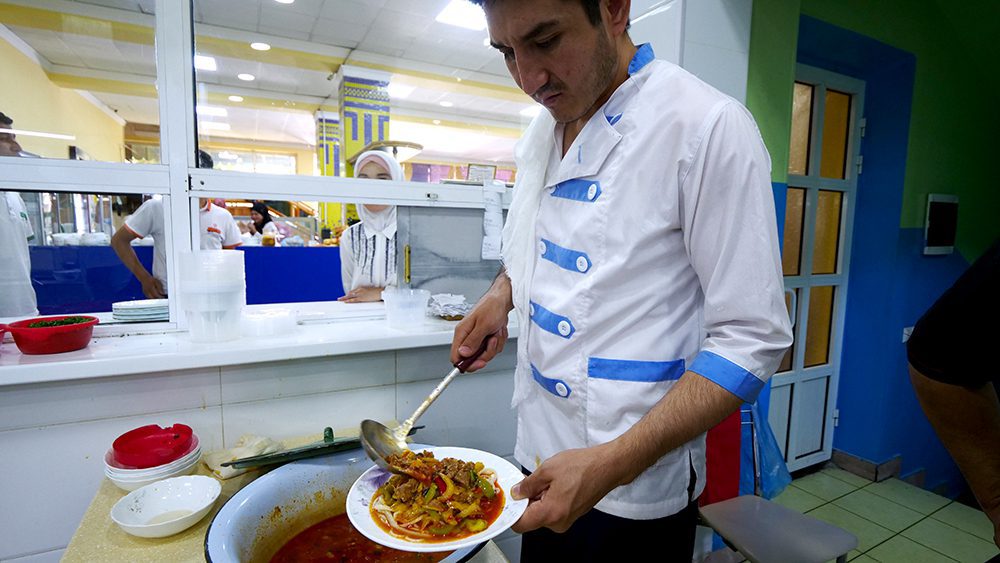
While the dish is mild in terms of heat and light on spices, so many delicious flavors still come through. I could tell it was made with love, and it actually reminded me of Italian pasta. You can’t beat soulful cooking like this!
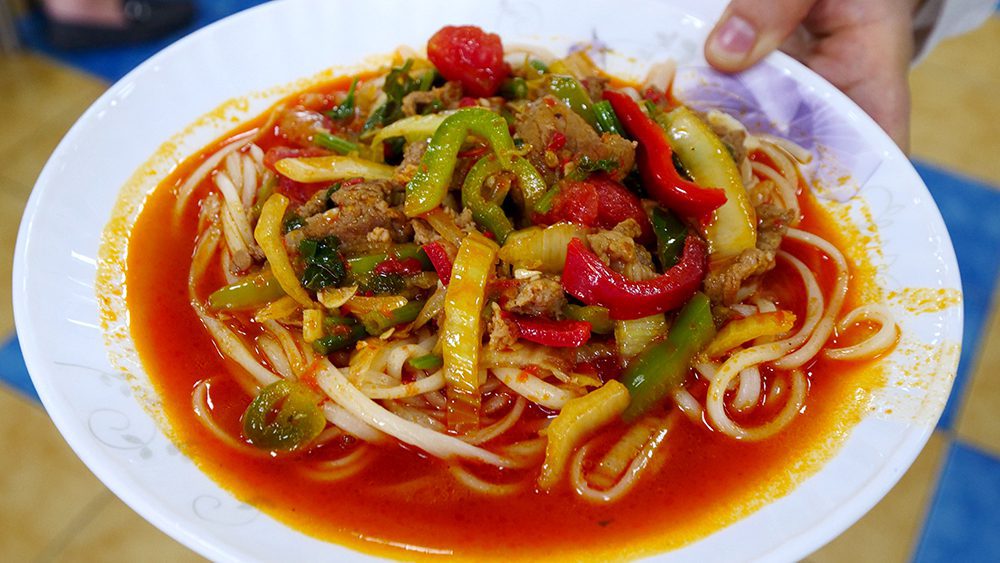
Enjoy your lagman with some fluffy and airy Uzbek bread. It’s served freshly baked and has a soft, fresh, and chewy texture like the crust of a well-made pizza. Try it with some chili oil for a nice kick of flavor. Don’t forget to try the incredible fruit juice at Lagman House while you’re there! It has a sweet and unique flavor that’s almost like a cross between peach and apple!

As I mentioned earlier, Tashkent’s Old Town fell victim to a powerful earthquake in 1966, which left most of its historical buildings in ruin. Among the structures left standing after the quake were the beautiful buildings of the Khazrati Imam Complex. Taking a tour of it is, without question, one of the best things to see and do in Tashkent.

As you enter Old Tashkent to visit the mosque, you’ll probably notice the stark difference between it and the modern city. You won’t find wide, Soviet streets or lots of apartment blocks here. Instead, the streets of the Old Town are much narrower and lined with smaller houses. It feels more like the countryside.
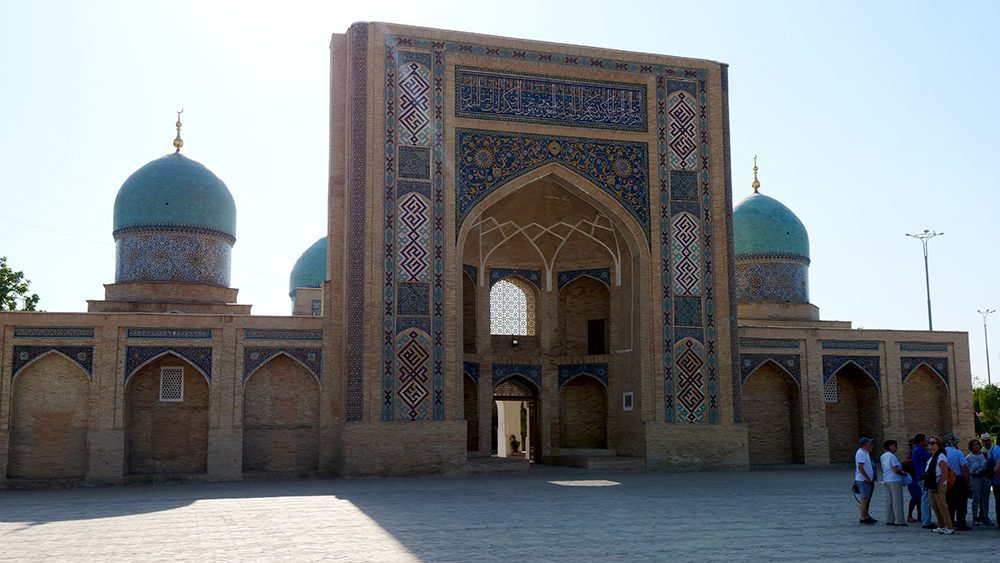
The complex is the most popular historical site and the main Islamic center in the city. It’s made up of the Barak-Khan Madrasah, the Tilla Sheikh Mosque, the Muyi Muborak Madrasah, the Khazrati Imam Mosque, the new Al-Bukhari Islamic University, and more. The oldest buildings in the complex date back to the 16th century.
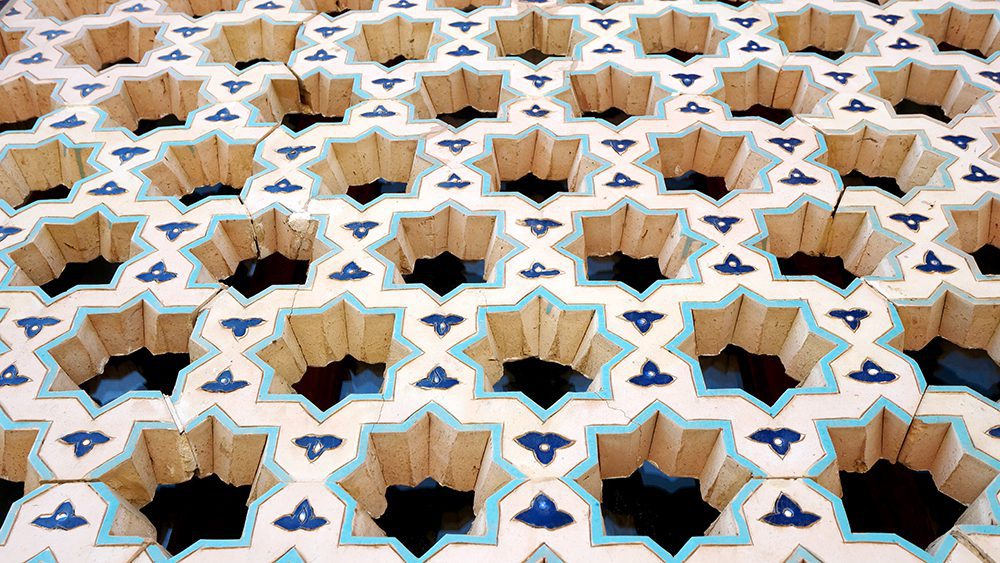
Khazrati Imam Mosque is a massive, 19th-century building that features a silver dome, a wooden veranda, and two minarets. The mosque dates back to the 16th century and is massive! Though the mosque doesn’t clearly honor one person by name, the inscription above its door is thought to reference a holy man from the 9th century named Abu Abdulla Muhammad ibn Nasr al Keshi.

Another notable site within the complex is the 16th-century Muyi Muborak Madrasah. This madrasah is said to house preserved hair from the prophet Muhammad. In addition to that, the building is also home to the Uthman Koran, also known as the Samarkand Codex and the Tashkent Koran, among others. This 8th-century Koran, written in Kufic script, is significant because it is thought to be the oldest Koran in the world.

The Uthman Koran once belonged to Uthman ibbn Affan, the third of the four Righteous Caliphs who succeeded Muhammad. The book, which has centuries-old blood droplets on its pages, is considered a national treasure.
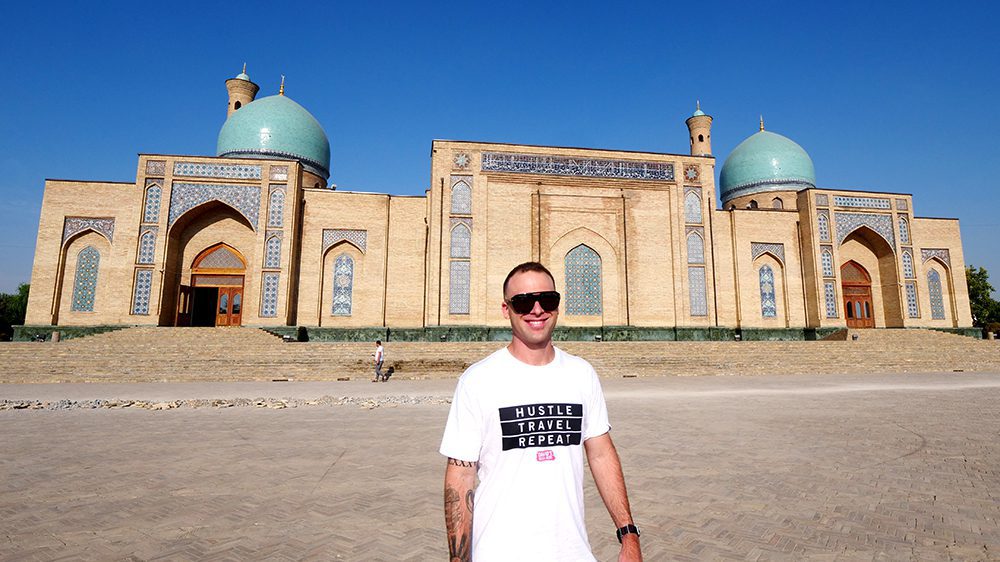
Even if you don’t have the time to explore the entire Khazrati Imam Complex, be sure to check out the Uthman Koran. It’s an irreplaceable piece of Islamic history and is among the best things to see and do in Tashkent!

No visit to Tashkent is complete without visiting and exploring the sights, smells, and sounds of Chorsu Bazaar. This massive market is Tashkent’s largest and oldest traditional bazaar. It’s best known for its gleaming central dome, which is covered in blue and green tiles and houses countless vendors selling everything from fresh horse meat to spices to dried fruit.

It may not be apparent right away, but Chorsu Bazaar is also a wonderful spot to try traditional Uzbek street food. In fact, it’s one of the few places in the entire country I found that actually serves street food. The street food vendors are extremely friendly and usually more than happy to feed you samples of their dishes. Even though Chorsu Bazaar is very important to local life in the city, it still doesn’t receive many tourists. So, when one shows up, the vendors are excited to share their food and culture with them.
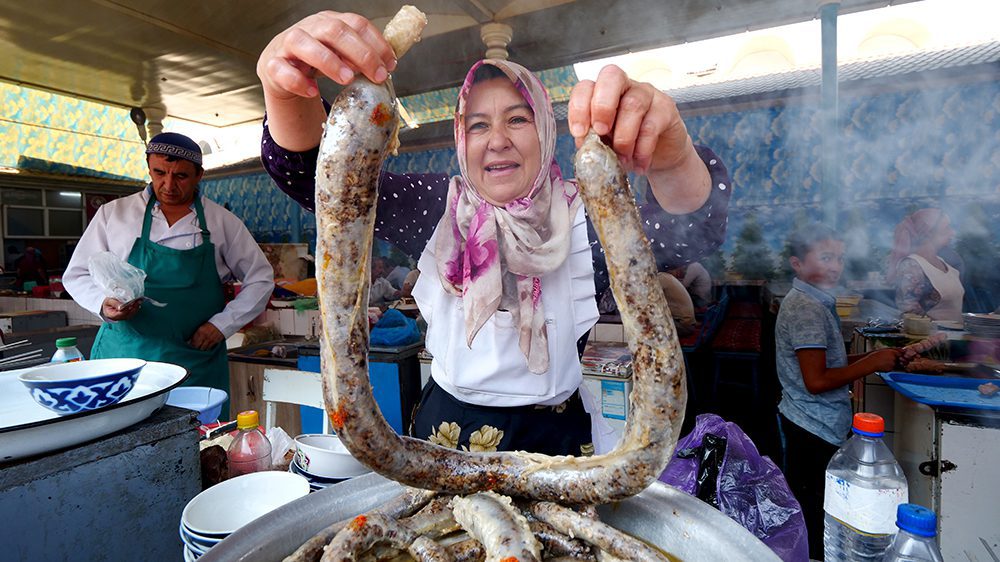
Take note that Uzbek cuisine is very heavy on meat, so vegetarians may not have much luck here when it comes to food. But if you’re a carnivore, be sure to try out the hasib, a tender lamb-intestine sausage served in a tasty broth. The sausage absorbs the flavors of the broth, which creates a flavor explosion in your mouth. If you find yourself with a sore, scratchy throat like I did because of the dry air, this soup is the perfect way to soothe it!

You also should not skip the norin, a traditional wheat pasta dish with horse meat and onions. The pasta doesn’t have much flavor, but the gamy horse meat and acidic onions more than make up for it. It’s a dense, flavor-packed horse salad!
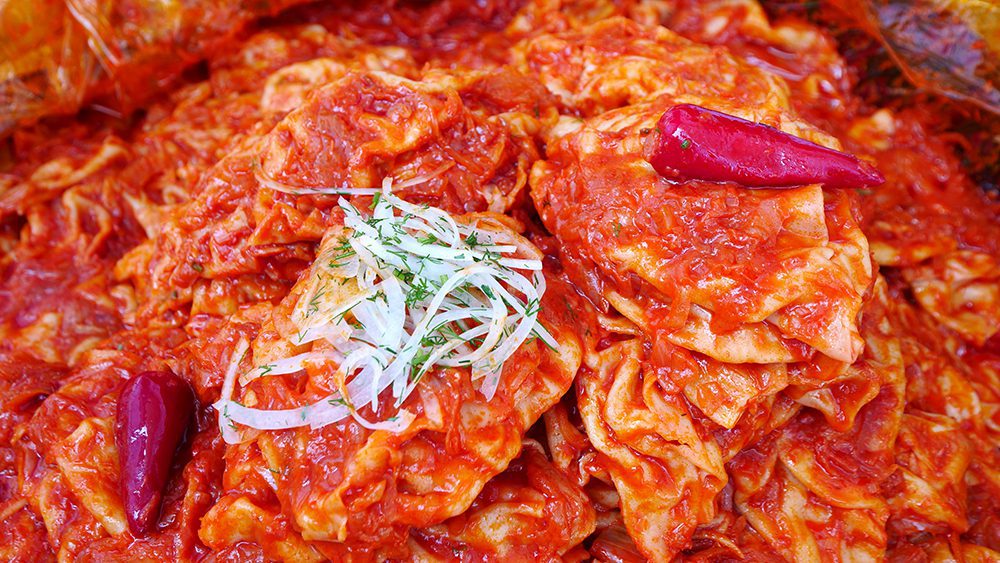
One of my favorite things to see and do in Tashkent was to try the honim at Chorsu Bazaar. It’s like a thin dumpling that is packed with thinly sliced potatoes and coated in a sauce made from tomatoes and chilies. It’s served topped with onions and tastes similar to Italian pastas.
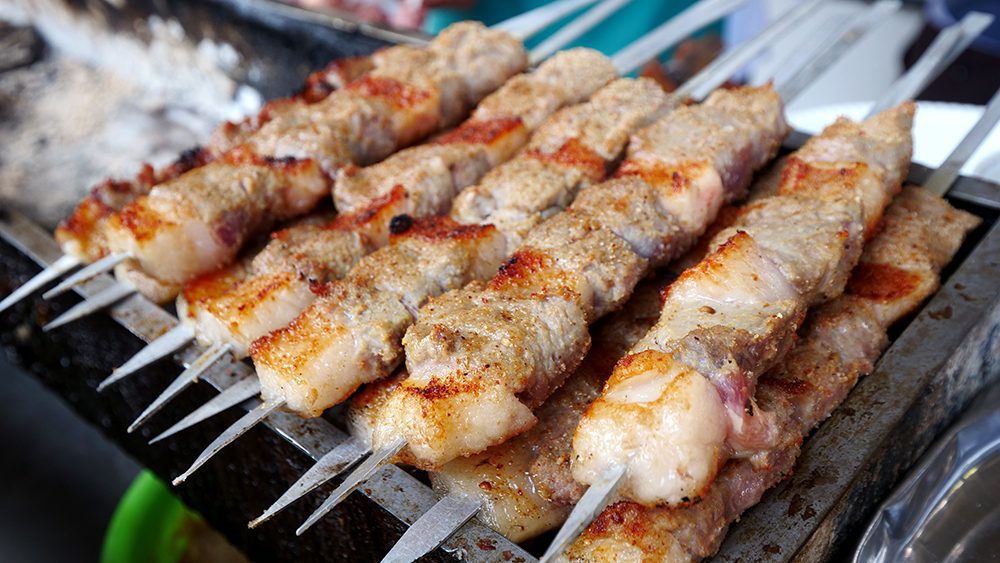
You also can’t miss the beef kebabs, which are cooked with lamb fat. The combination of the two made it one of the most phenomenal kebabs I’ve ever had in my life. They’re tender and juicy and have a breaded crust that adds a new layer of texture that contrasts nicely with the tender meat and gelatinous fat.
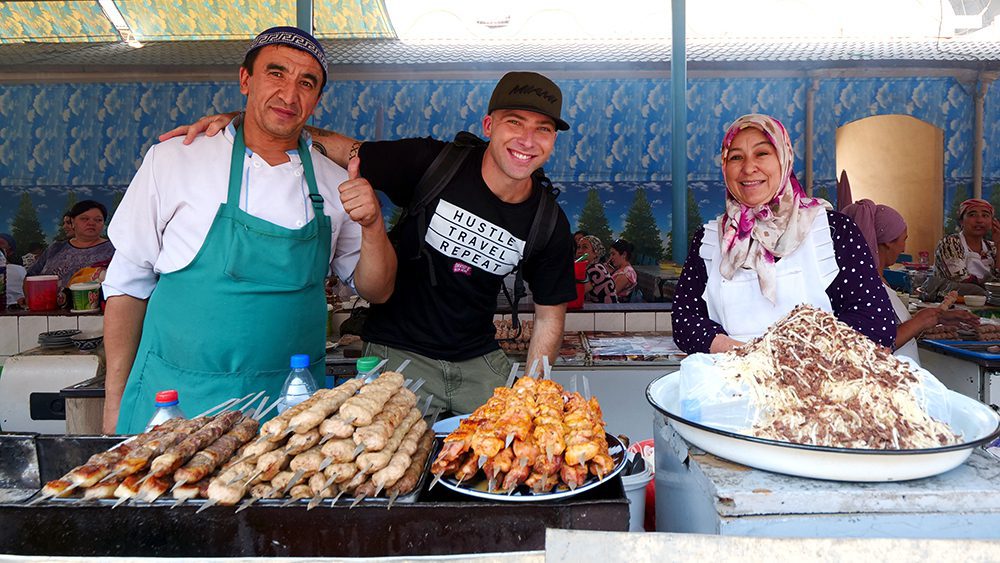
Meals in Uzbekistan are immediately followed by green tea. At Chorsu Bazaar, the tea had a splash of lime in it, which really helped my dry, scratchy throat.

After you’ve eaten your fill (or before, depending on your preference), be sure to check out the domed bazaar. There, you’ll find vendors selling clothes and gorgeous crafts like pottery and decorative plates. But Chorsu Bazaar is known for its meat vendors, who sell various cuts of horse, chicken, lamb, and beef. You can also find sausages, various organ meats, and even cow bones!

On the upper floor of the domed bazaar, you’ll find vendors who mostly sell spices and dried fruit. Like the vendors in other parts of the market, they’re very friendly and allowed me to sample some of their goods. Don’t miss the chewy dried apricot and dehydrated kiwi – they’re both unreal!

Lastly, you’ll want to check out the on-site souvenir market, which you’ll reach by winding your way through the clothing vendors. There, you’ll see vendors offering clothing and accessories like hats, vests, bags, and leather boots. You can also find more decorative plates, fruit bowls, jewelry boxes, pottery, and much more. It’s a great spot to buy gifts for friends and family!

During my time at Chorsu Bazaar, my guide Bobur told me that the two best things to eat in town are the beef kebabs and the plov. With one of the two checked off my list, we headed to the next place on our list of things to see and do in Tashkent, Plov Center!

Plov is a traditional rice dish that is very popular around Central Asia. It’s also the national dish of Uzbekistan and is eaten in both rural and urban areas. It’s traditionally served as a sign of hospitality but is also eaten at celebrations such as weddings. Plov is even eaten to honor family members who have passed away. Because of the way it has been woven into the tapestry of rich, Uzbek traditions, plov is recognized as a UNESCO dish.

Plov has lots of regional variations, but in essence, they’re all pretty similar no matter where you have it. At Plov Center, it’s made with white and yellow rice, beef, lamb, yellow carrots, chickpeas, raisins, quail eggs, and horse sausage. You can order it from either a vendor or a waitress. I suggest going with one of the seven vendors, as the waitresses take longer. And at 25,000 som, or about $3 USD, you can’t beat the price!
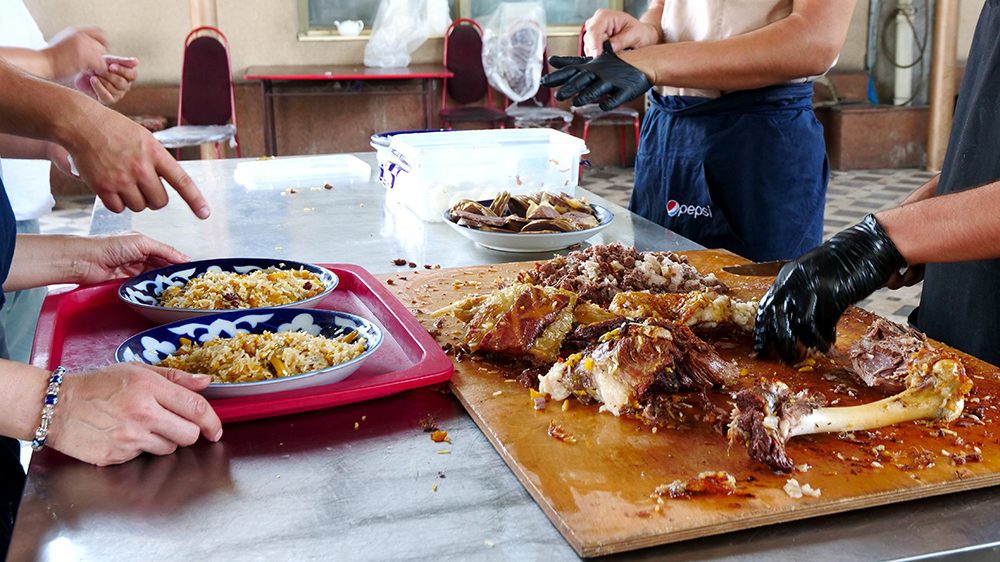
You can also take advantage of Plov Center’s self-serve policy to get bread, salads, and fresh fruit juices, or you can order them from a waitress. I suggest serving yourself and heading upstairs so you can enjoy your meal with a view of the entire restaurant.
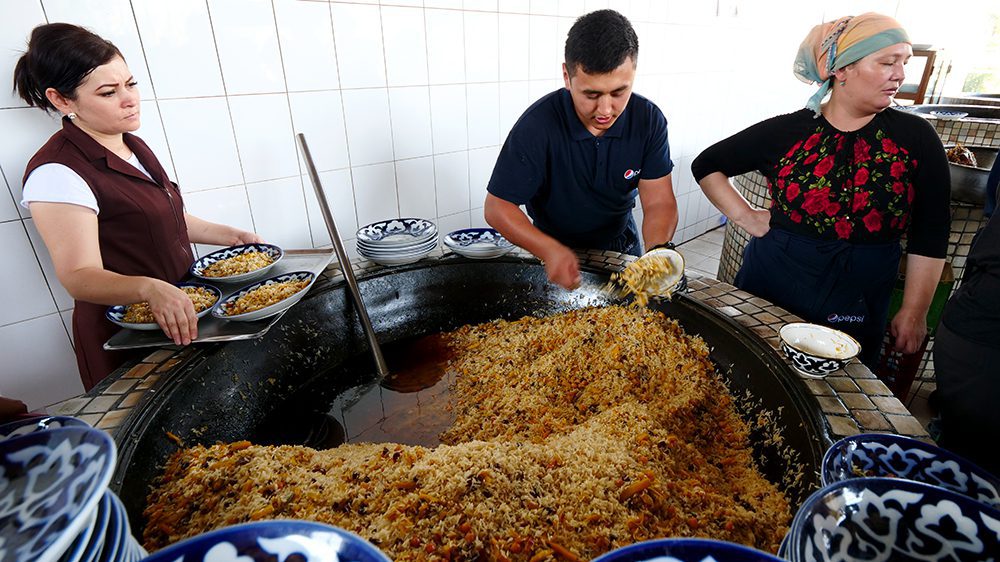
The yellow carrots and raisins make the plov a little sweet, which balances out the oiliness of the rice and the hearty, gamy, and salty meat. The horse sausage, in particular, pairs extremely well with the rice. The flavors of the horse, beef, and lamb are the perfect, meaty marriage, and together, the flavor is downright explosive.
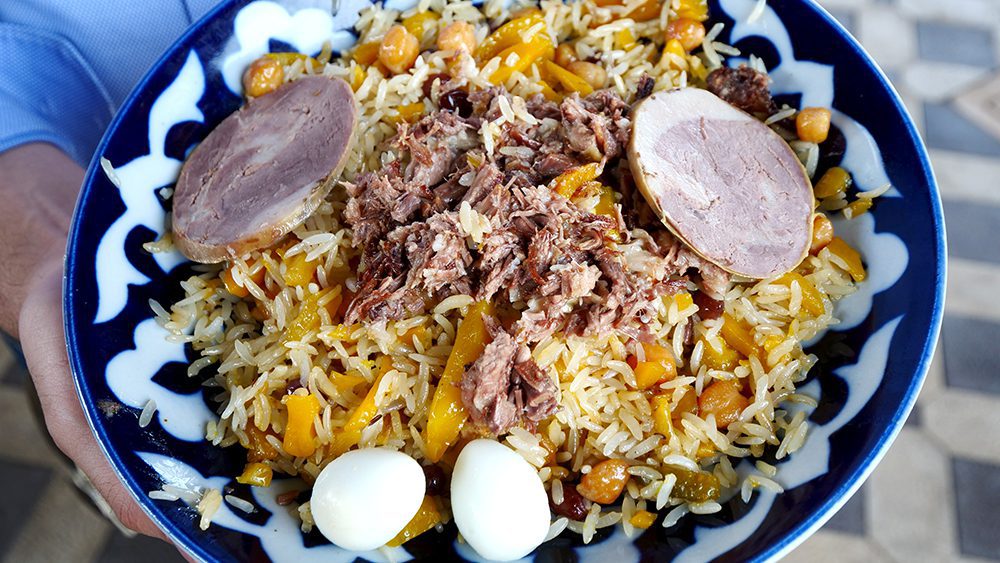
The vegetables add a brightness and freshness. All in all, the plov is a culinary masterpiece of contrasting textures and complementary flavors. It’s also quite different from other rice dishes from around the world like biryani and paella!
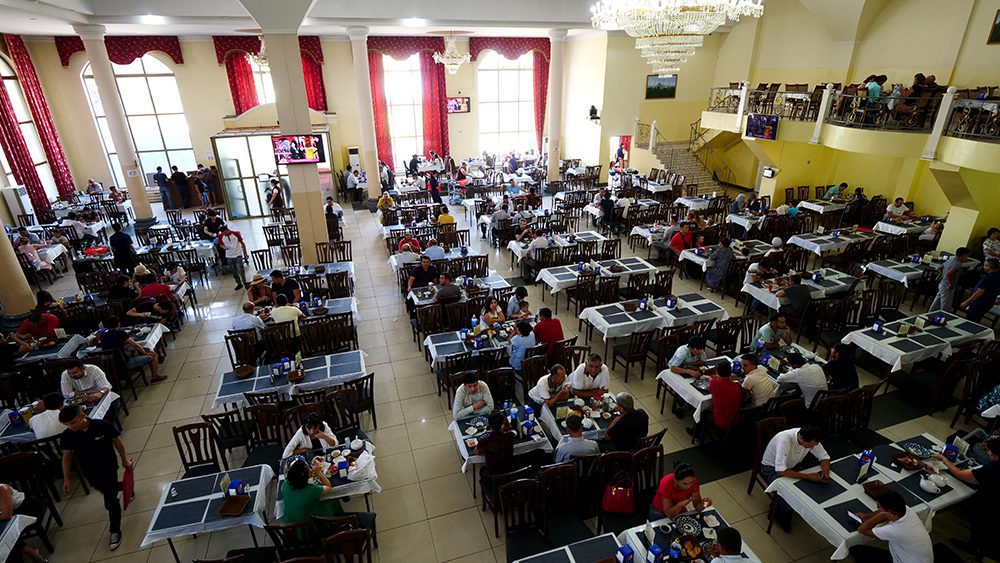
One of the few veg-only dishes you’ll consistently come across in Uzbekistan is Achichuk salad. It contains tomatoes, cucumbers, and onions and is similar to a Greek salad. You can also try a second salad made with cabbage and pickles. I recommend mixing some of the salads into the plov for even more flavor! If you miss the plov and salads here, you’re missing one of the top things to see and do in Tashkent.
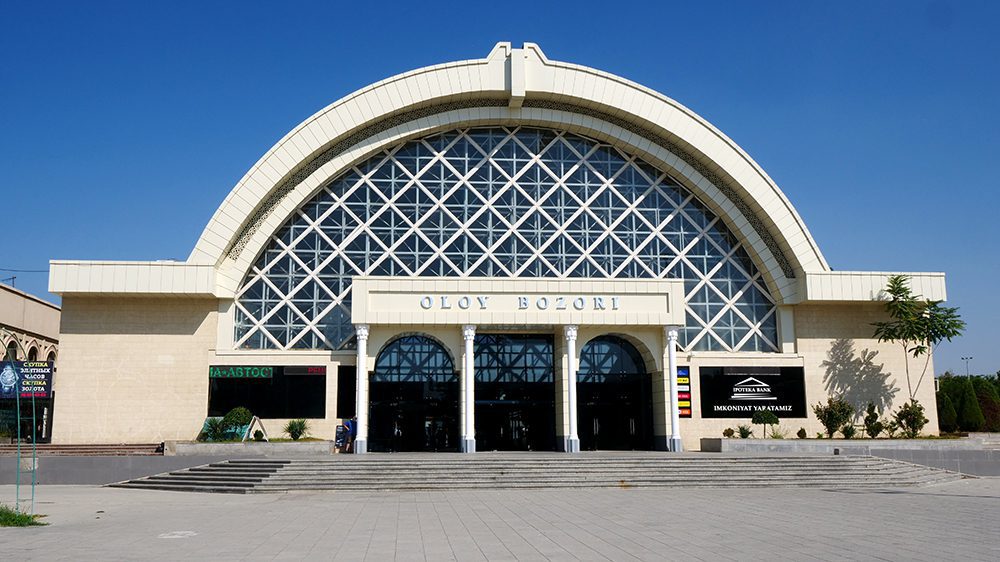
While Chorsu Bazaar is Tashkent’s old-school, traditional, and grittier market, there is a second bazaar that should be on your list of things to see and do in Tashkent. Oloy Bozori, also known as Alay Bazaar, is more of a produce market located in a pretty, modern building. Inside, the bazaar has a very modern feel, as it’s cleaner and well-kept, and has 30-40-foot-high ceilings.

Unlike Chorsu Bazaar, you won’t find much in the way of meat at Oloy Bozori. However, you will find vendors selling high-quality fruit, vegetables, spices, and nuts as far as the eye can see. But even with the differences between the two, there was one charming similarity: the friendliness and hospitality of the vendors.
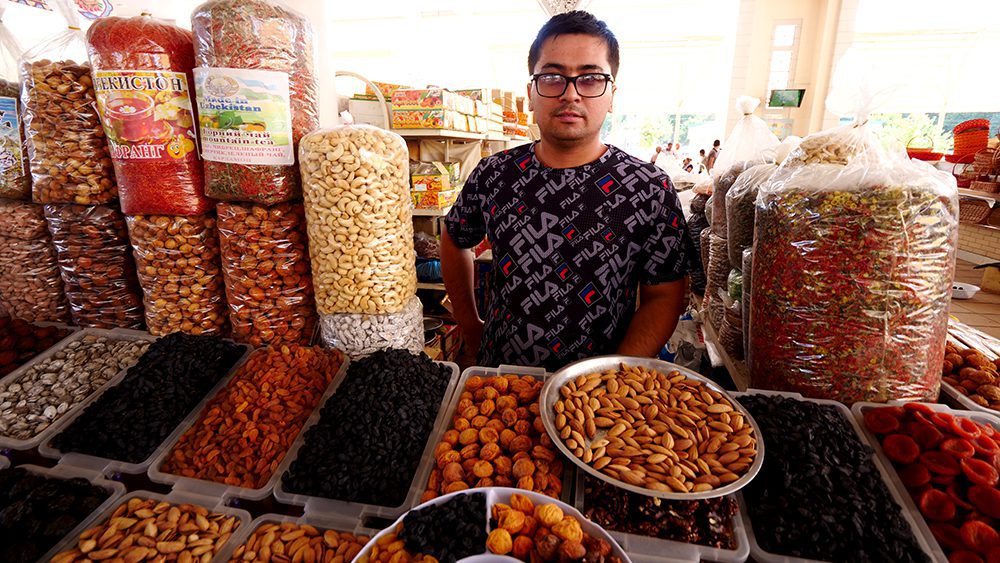
As I explored the bazaar with my friend and guide Bobur, vendor after vendor beckoned me to try their finest products. I tried some tasty figs and some small and out-of-season strawberries that surprised me with how good they were. I also was given some medicinal-tasting green tea that gave me a jolt of energy and some light and herbal Samarkand mountain tea.

If you’re a cheese lover, you’ll also want to try the Uzbek milk balls. They are as fresh as they come and smell like a strong, unpasteurized cheese! The flavor was equally strong and tasted almost like drinking milk straight from the cow! Whether you walk away liking it or not, trying one is one of the top things to see and do in Tashkent!

Like many families around the world, my family was directly impacted by the events of World War II. My grandparents met during the horrors of the war, and if they hadn’t met, I would not be here today. This war changed the world in small ways like that, as well as large ways that have had a direct impact on how we live today. Because of that, whenever I visit World War II memorials, I like to pay tribute to those who fought so future generations could be free.
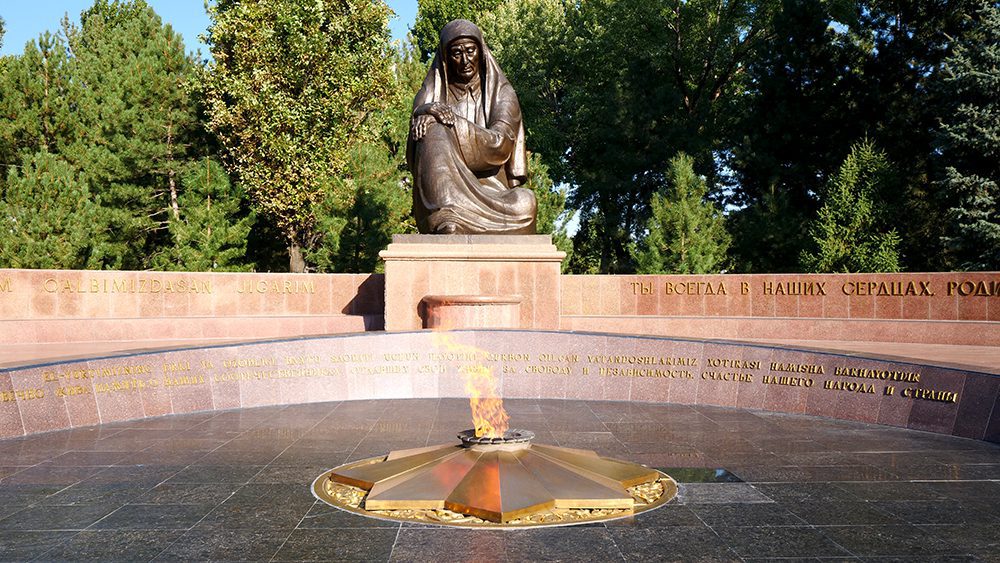
The best place to do that in Tashkent is Independence Square, the largest square in the city. Before the Soviet Union fell in 1991, it was known as Lenin Square, but the monument to the former Soviet head was dismantled the following year. It was replaced with a large globe statue known as the Monument of Independence of Uzbekistan.
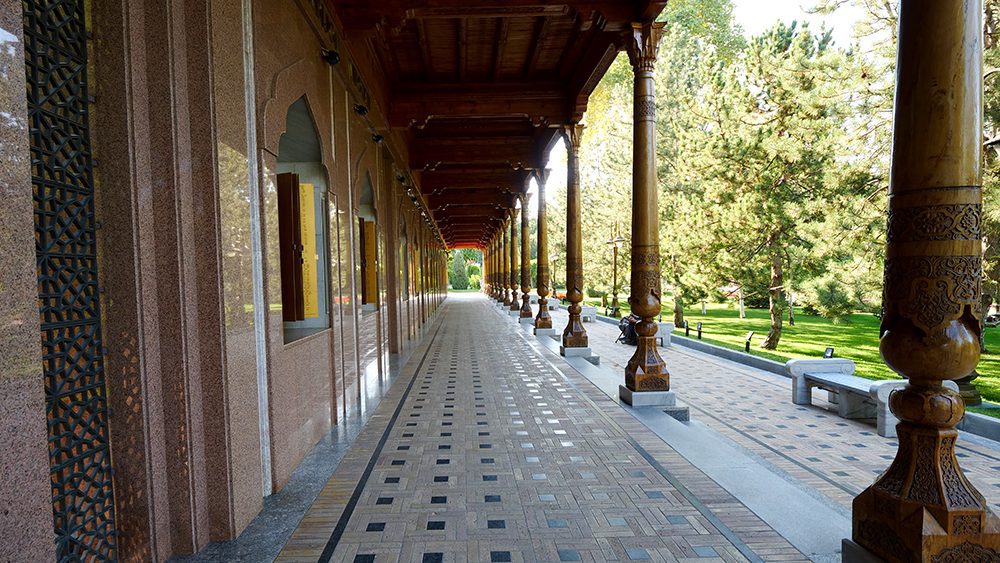
The square is actually more of a park than a square. It contains lots of trees and flower beds, as well as administrative buildings and monuments like the Monument of Independence and the Arch of Independence. But its most sobering features are those that acknowledge the country’s role in World War II.

At the monument known as Memory Lane, you can read the names of the Uzbek people who fought in the war. Nearby is an eternal flame and a Tomb of the Unknown Soldier that honors Soviet soldiers who fought in the war. These monuments are powerful reminders that, even half a world away the place you call home, are people and families who were forever changed by the war. Be sure to stop by and pay your respects when you visit Tashkent.

I’ve talked a lot about the tender, mouthwatering meat that’s very much a staple in Uzbek cuisine. But I haven’t even touched on the magic that is Uzbek fried chicken. To try the most incredible fried chicken in Tashkent, you’ll need to head over to Ugolok, a 55-year-old restaurant next to the main street.

Ugolok is known for their fried chicken, particularly their fried chicken tabaka. The recipe is as old as the restaurant it’s cooked in, and they only use organic chicken. But the real kicker is how they fry the chicken. Instead of using oil, the cooks at Ugolok fry their birds in butter!
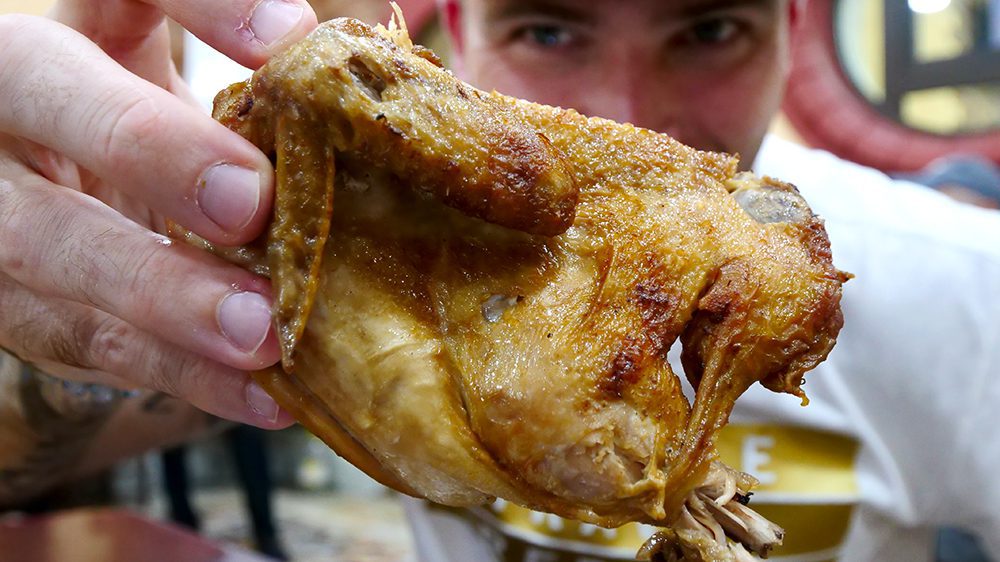
The end result is a chicken that is juicy, slightly salty, and bursting with buttery chicken flavor. When I visited, I ordered a wing and leg and was genuinely blown away by its freshness and the amount of meat on the bones. I could taste the fact that it was an organic chicken, free of chemicals and hormones, that was freshly butchered and had never been frozen.
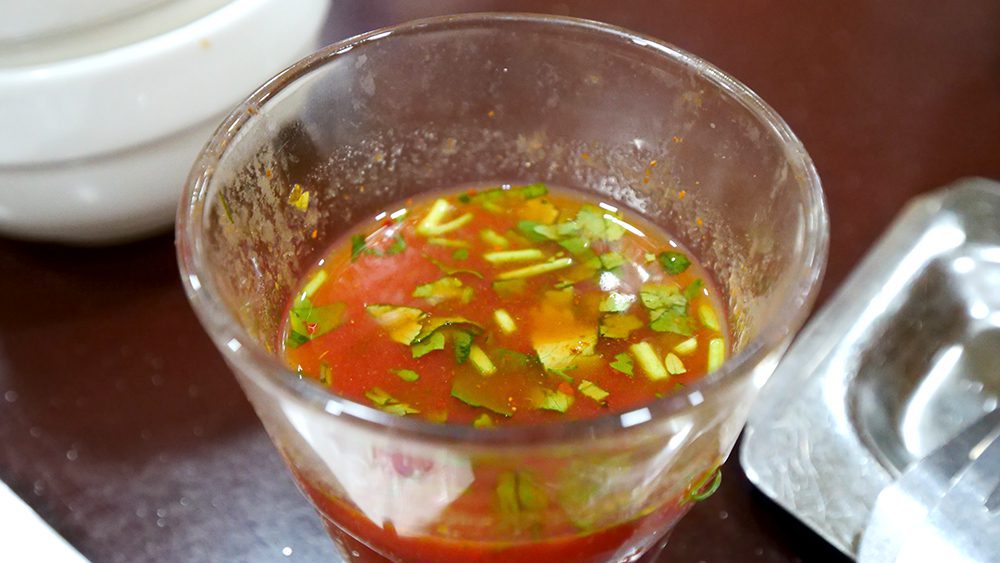
It was literally farm-to-table, which is exactly the way I like to eat. Try the chicken with some bread to make a moist, flavor bomb of a sandwich. On the side, I have a delicious tomato drink from Ugolok’s menu. It’s reminiscent of a gazpacho and goes really well with the buttery chicken!

So, even though the lamb (and to a lesser extent, the beef) in Uzbekistan tends to take center stage, its stellar chicken also deserves some love. Having the fried chicken tabaka at Ugolok is one of the top things to see and do in Tashkent. If you love good chicken as much as I do, this is a can’t-miss opportunity!

I mentioned earlier that, following the 1966 earthquake that devastated much of the old part of Tashkent, the Soviets rebuilt the city in their image, with wide streets, lots of plazas, and apartment blocks. But what I didn’t mention is that the most impressive—not to mention, most beautiful—relics from the Soviet era are actually located underground. Yes, I’m talking about Tashkent’s metro stations.
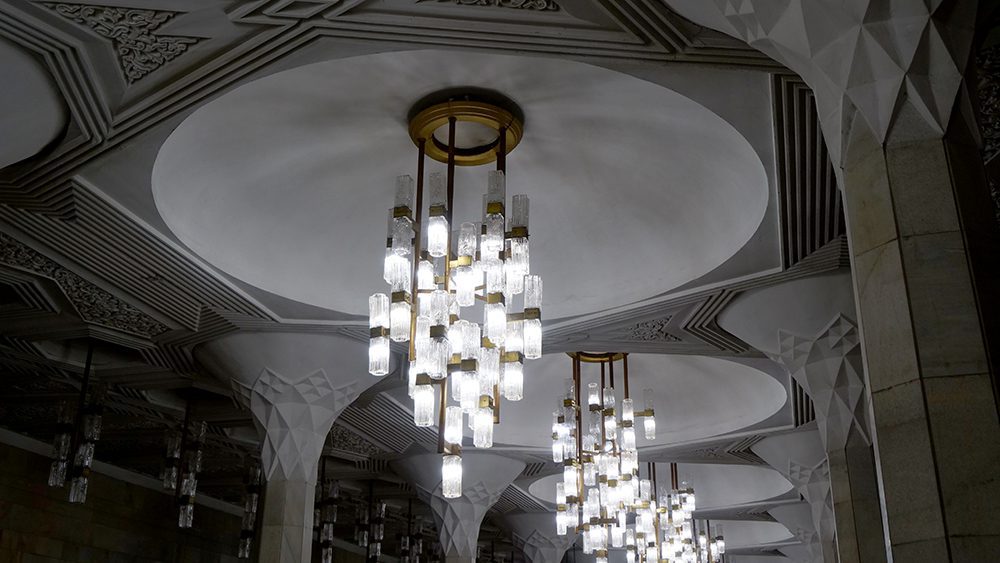
In 1977, the Soviets completed the seventh metro system in the USSR, located in Tashkent. As the cities in the USSR grew under Joseph Stalin’s rule, he needed a quick and efficient way to transport labor workers. At the same time, Soviet ideology decreed that metro stations were meant to display the beauty of Soviet life. The end result was some of the most ornate, colorful, and extravagant metro stations in the world.
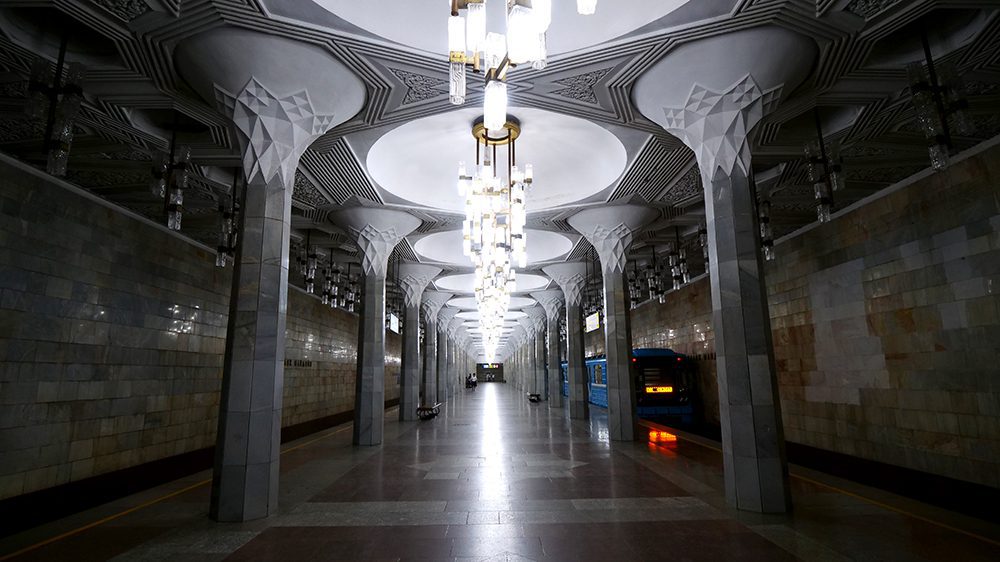
These stations are known for their intricate architecture, lavish décor, and the gorgeous tile work that adorn their walls. Some of them even feature fancy chandeliers and portraits of Lenin and Stalin. In addition to their beauty, many of the stations were also practical. Some of them even served military and strategic functions and doubled as bomb shelters.
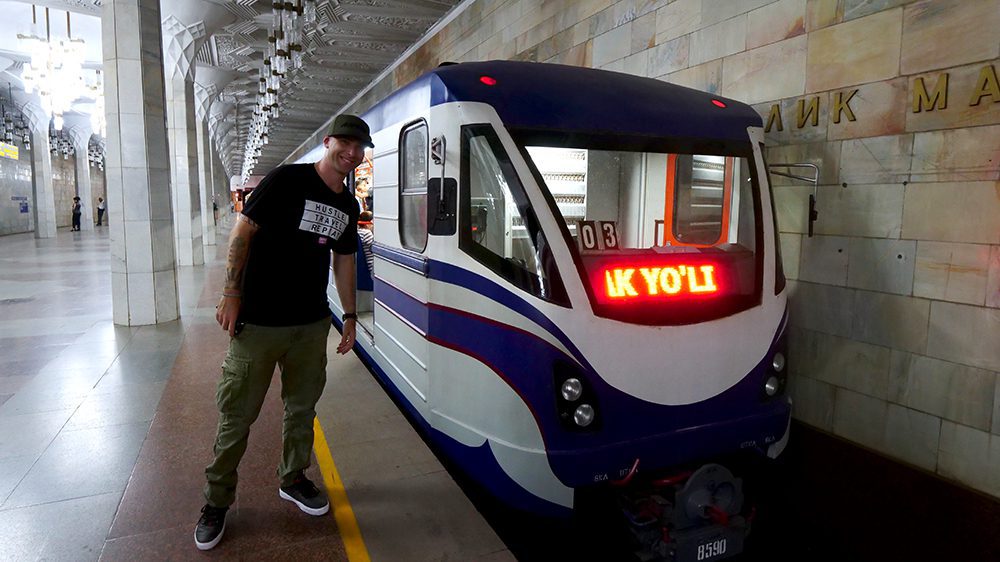
Until 2018, photography in the Tashkent metro system was forbidden. But as the government began realizing the appeal of the city’s metro stations, the ban lifted. For 1,400 som—about $1.50 USD—you can visit a local metro station. I had never seen anything like the one I visited. The marble pillars and chandeliers were stunning. I wish I could have visited more stations, but I was in too much of a time crunch to see more than one.

If you have the time, be sure to tour the Tashkent metro system. If the station I visited is any indication, it’s well worth the time it takes to do it. It’s easily one of the best things to see and do in Tashkent!

Visiting Uzbekistan, at least for me, is almost entirely about the historical, cultural, and gastronomical experiences you can’t really have anywhere else. But that doesn’t mean there aren’t places where you can just let loose and have fun. Tourists looking for an exciting place to explore and have fun, day or night, should head over to Broadway Street.
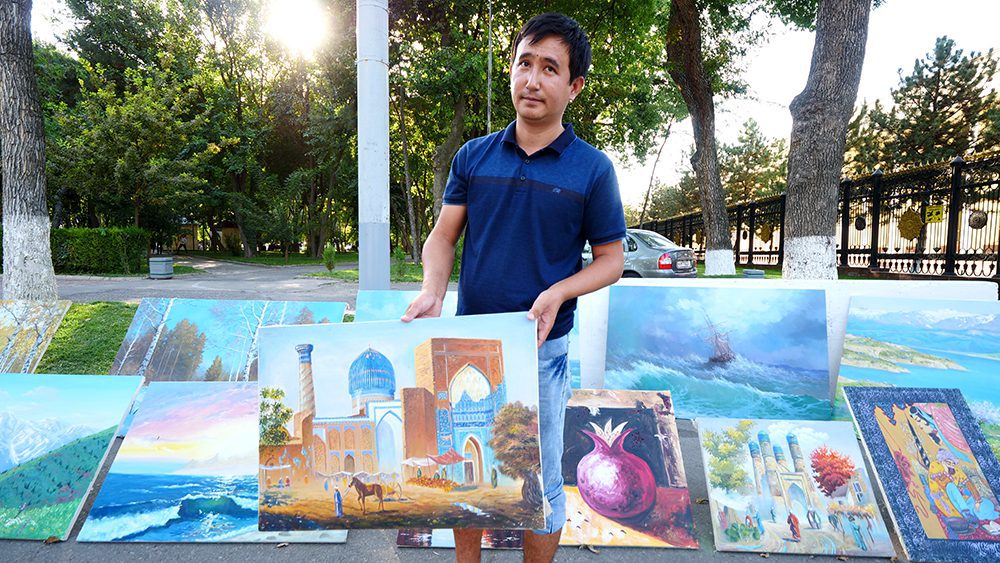
Here, you can find a bit of everything. One of my favorite things to see and do in Tashkent is to tour the craft-lined section of the street. There, you can find amazing handmade works of art, including decorative plates, jewelry, antiques from the Soviet era, silver utensils, pottery, and much more. It’s a fantastic place to dip your toe into the world of fine Uzbek craftsmanship, especially if you have yet to visit craftsman-centric cities like Bukhara and Samarkand.
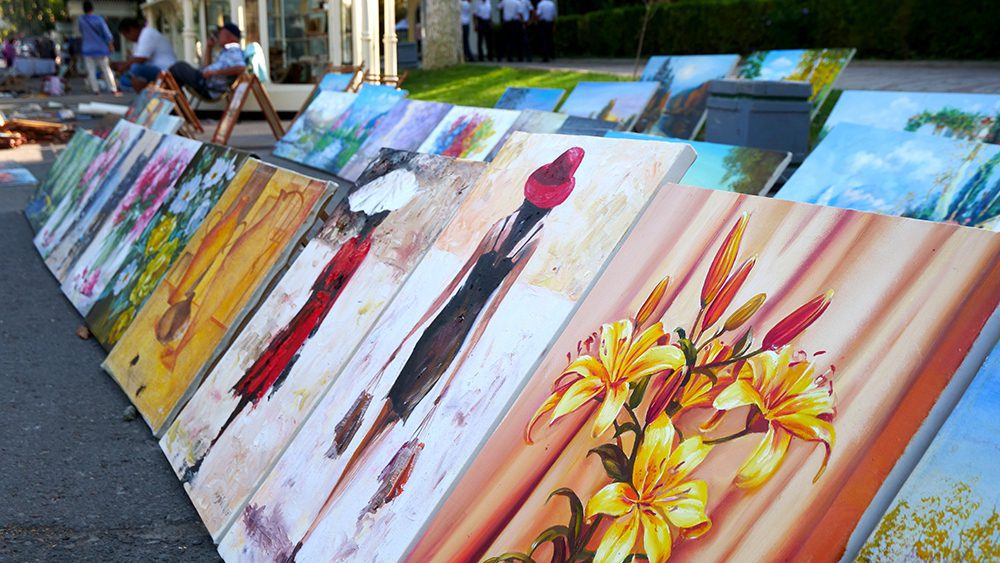
Some of my favorite vendors along Broadway Street are those selling paintings. As you browse the street, you’ll find hyper-realistic creations painted on stretched animal skins in wooden frames. The vibrant colors and amount of detail that goes into the paintings on display along the street is mind-blowing.
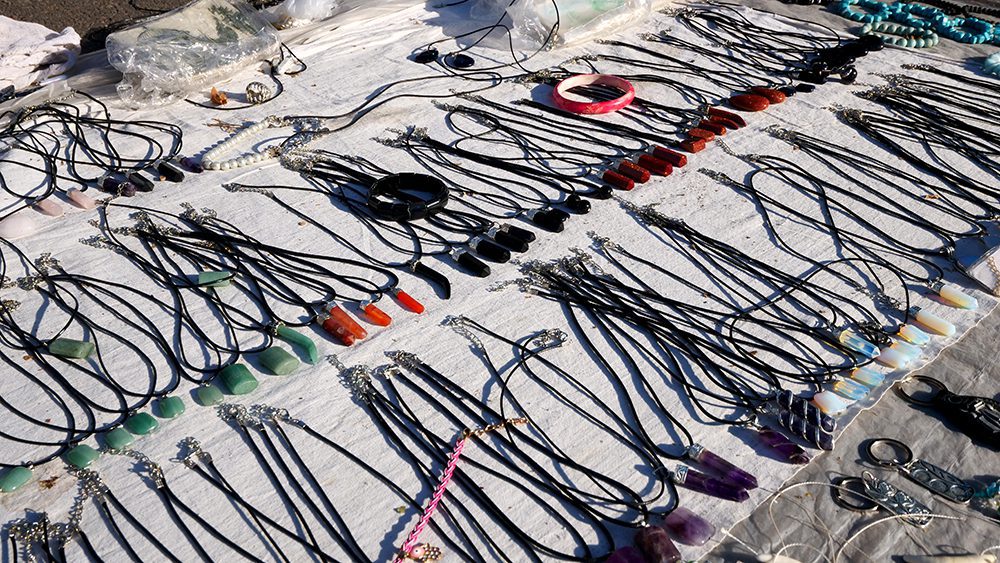
I met one vendor who created a beautiful painting of Samarkand that cost 450,000 som, or roughly $47 USD. It’s a remarkable deal for such a gorgeous work of art, especially since it took him 10 days to complete it! He even took 50,000 som off of the price for me.

But, as I mentioned earlier, Broadway Street is also a great place to have fun. You can get a street artist to do a portrait of you or someone else from a photograph for only $20 USD. It’s also an awesome spot to play games! I visited Broadway Street early in my Uzbekistan trip and again on my very last night in the country.
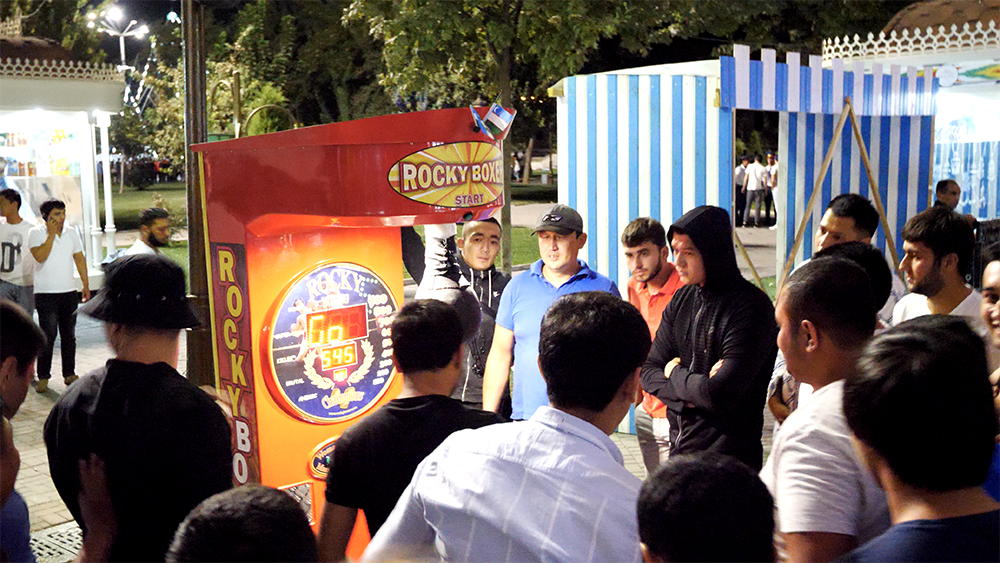
On my last night, I returned with some friends from the World Influencers Congress to blow off some steam after a long, hard trip around the country. If you come with friends, challenge them to a dart game to see who can burst the most balloons, or attempt to climb to the top of a swaying ladder without making it twist! The further you climb the ladder, the more money you make!
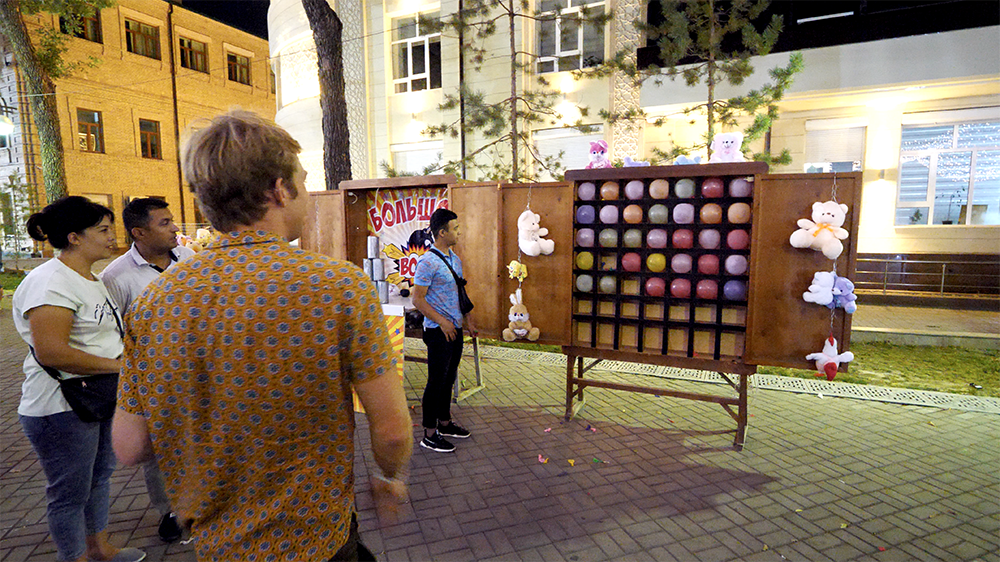
Further along the street, you’ll come across more kiosks with games, as well as fast food places selling hot dogs and hamburgers. It’s no wonder locals go there to meet and have a good time!

If there’s one name that’s synonymous with Uzbekistan’s long history, it’s Amir Timur. Timur, who was born in 1336, was a Turco-Mongol Persianate conqueror. He was born in Transoxiana, an ancient area of Central Asia that is now made up of modern-day Uzbekistan and Tajikistan, as well as parts of Kyrgyzstan and Kazakhstan.
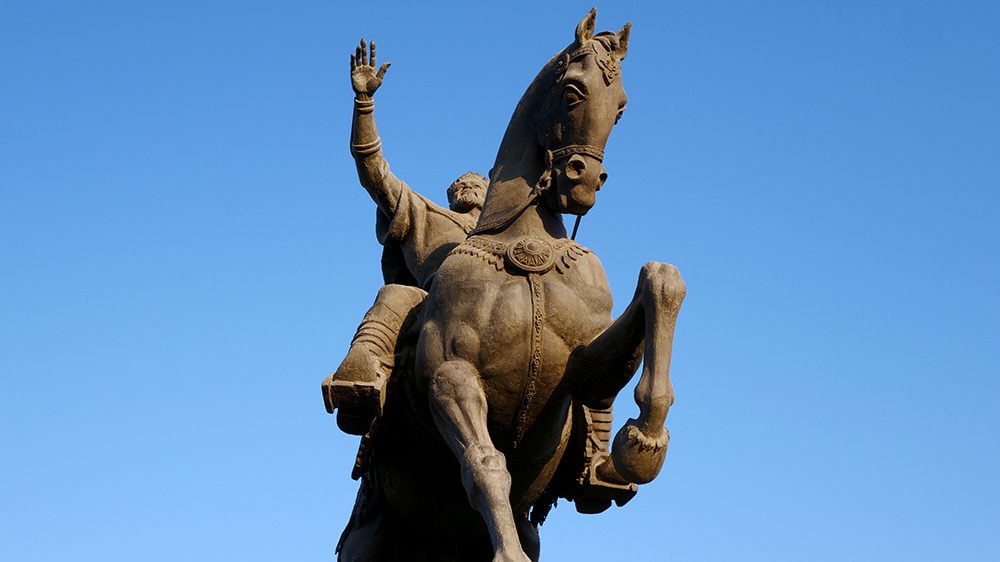
Timur founded the Timurid Empire in Central Asia and was the first ruler of the Timurid Dynasty. He was also a feared military commander throughout Asia, Africa, and Europe at the time and later became known as one of the greatest military leaders in history.
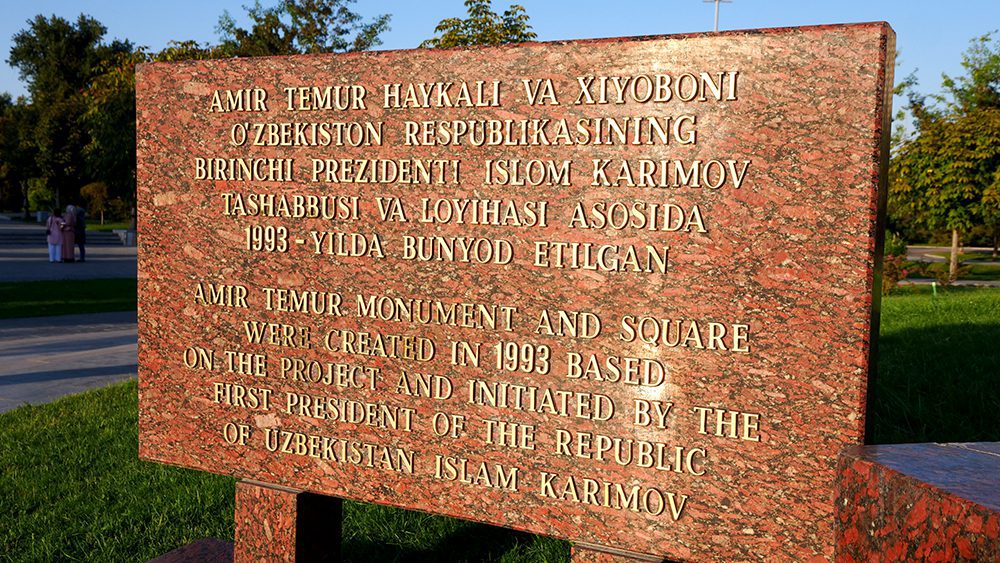
Timur’s legacy throughout Uzbekistan is apparent, as he is honored with several monuments throughout the country, including in Tashkent and Shahrisabz. Many of the most important structures still standing in the country were constructed either during his nearly 35-year reign or were influenced by his preferences.
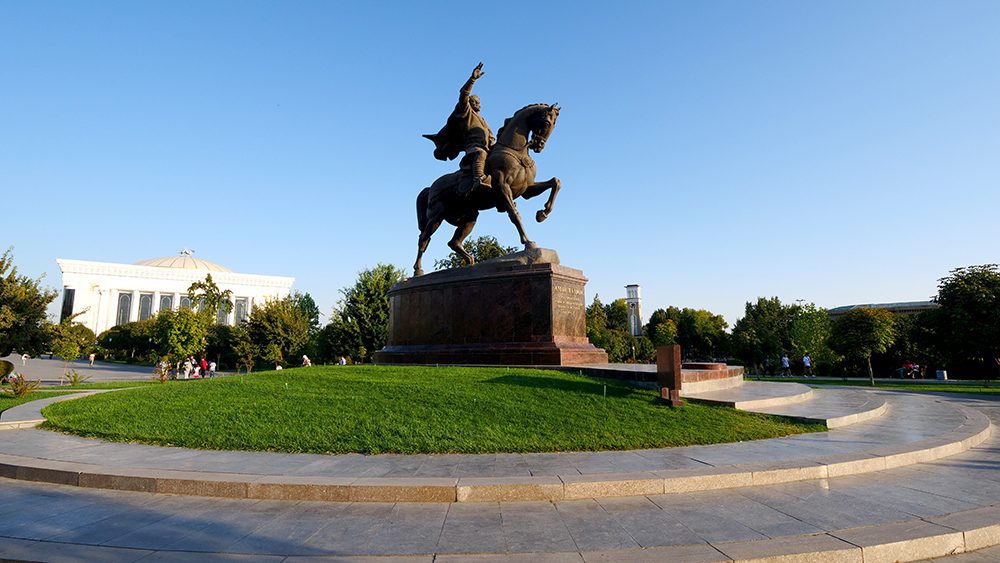
His monument in Tashkent can be found in the center of Amir Timur Square in the heart of the city. It depicts the famous commander in his imperial regalia, atop his horse. On the monument’s plinth are the words “Power is in Justice” in four languages. The square, established in 1882, is bounded by other notable locations including the Amir Timur Museum, the Tashkent Chimes and Forums Palace, and the University of Law. It’s a great place to begin your adventures in Tashkent!
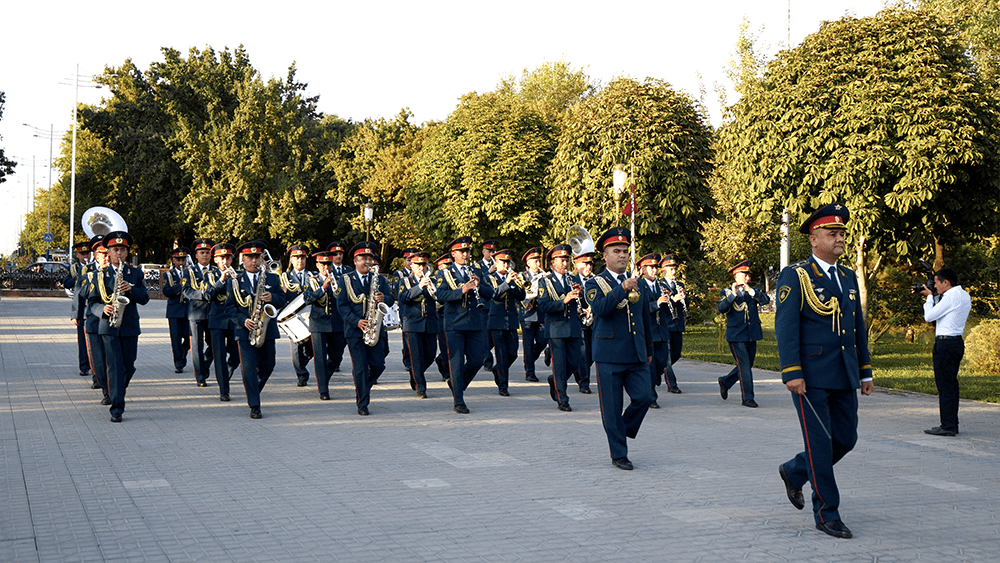
During my time in Tashkent, I spent as much time as I could exploring the city and immersing myself in its culture. Most of my itinerary was planned beforehand, as I worked with the World Influencer Congress for the majority of my time there. But I also had a couple of special and unexpected experiences on my own.

While I was at the town square, not far from Ugolok Restaurant, I had the incredible opportunity to witness a marching band perform as they made their way through the square. It was such a pleasant surprise and yet another insightful look into life in Uzbekistan’s capital city. And while I’m not sure if this is a daily occurrence or if I just happened to get lucky, it was an awesome experience. If you happen to experience it, too, have a great time and enjoy the music!

Of all the restaurants I visited in Tashkent, one of my favorites is the Sultan Saray Family Restaurant. It’s a traditional restaurant in the downtown area just a few minutes’ walk from the Hyatt Regency. If you’re staying there, it’s conveniently located. The restaurant has a nice, cozy atmosphere and is a great place to visit with family or a group of friends.

I dined at the Sultan Saray Family Restaurant on my last night in Tashkent with friends from the World Influencers Congress. I highly recommend the lamb chops, which like the rest of the food in Uzbekistan, are farm-to-table. It’s juicy and fatty and extremely fresh. I also suggest trying their tasty dolmas, bread, crispy potatoes, and Uzbek dumplings. They’re all fantastic and help make eating at the Sultan Saray Family Restaurant one of the top things to see and do in Tashkent!
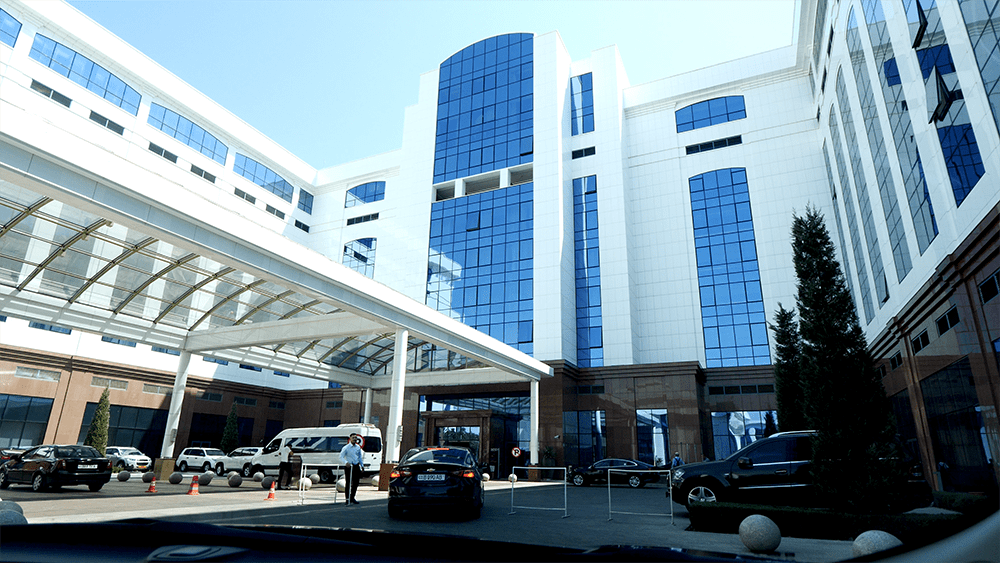
During my time in Tashkent, I stayed at the Hyatt Regency Hotel. It stands on Navoi Street in the downtown area, not far from Amir Timur Square. There are four restaurants, bars, and lounges in the hotel, as well as a state-of-the-art pool, spa, and fitness center.

As you might expect from the Hyatt, the accommodations are exceptional. My first time at the hotel, I stayed in a very nice, spacious room on the sixth floor. that boasted two twin beds, a very chic and modern bathroom, a desk where I could work, and a view of the building. Each room has a charging station, and the bathrooms boast a walk-in rain shower, and a large, separate tub!

When I returned to the Hyatt Regency on my final night in Tashkent, I met up with my friends Joey and Alex and headed up to their rooftop lounge for the first time. There, we enjoyed a few drinks in the luxurious and relaxing rooftop space before we had to take off the following morning.
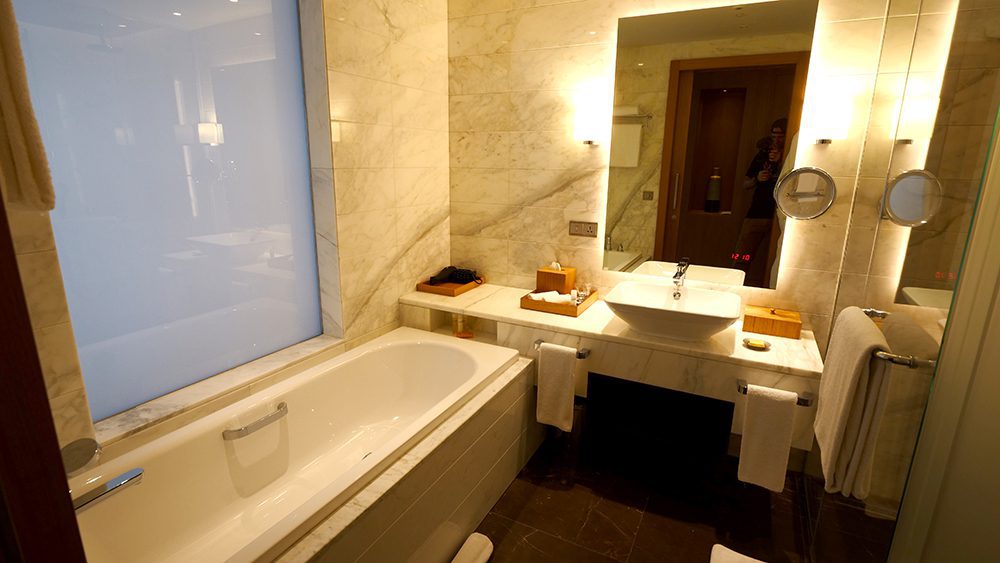
While you can order everything from a Moscow Mule to water, I recommend having a limoncello. They’re very strong and are made in the hotel! If they have them when you visit, take advantage of it. Once they run out, they won’t have another supply available for months! I actually got their very last glass of it!
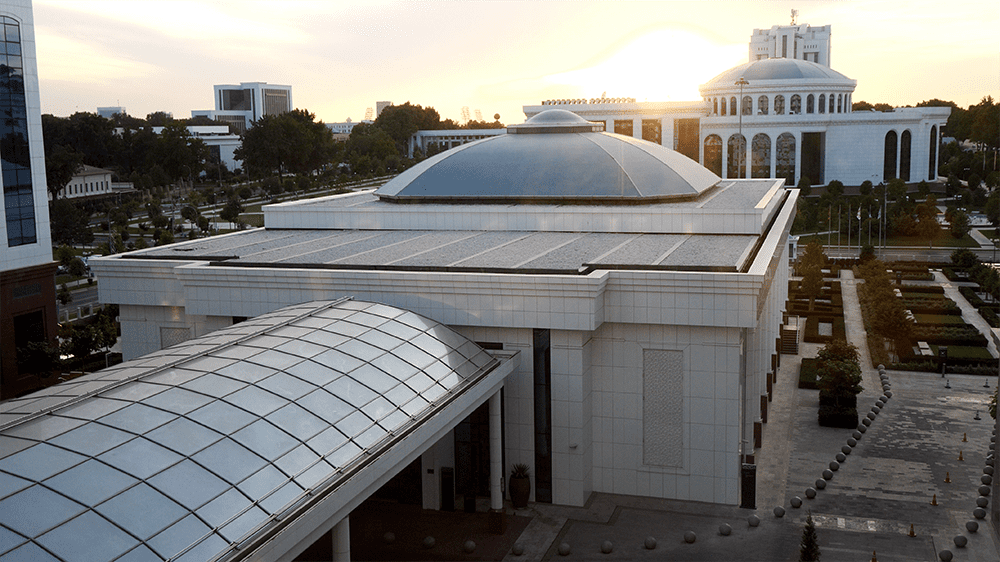
Staying at the Hyatt Regency is one of the best things to see and do in Tashkent. They’re the best and most comfortable accommodations around and offer anything you could possibly need while you’re there! Enjoying them is one of the best things to see and do in Tashkent!

The modern-day city of Tashkent, Uzbekistan may not boast the sheer number of astounding UNESCO sites as some of its Uzbek neighbors, but it still has a charm that’s all its own. Whether you find yourself on the hunt for authentic Uzbek cuisine, want to experience a traditional bazaar, or are looking to explore the history of the Soviet Union, you can do it all in Tashkent. Along the way, you’ll meet friendly locals and get to feel Uzbek hospitality up close. Book a trip to Tashkent today to see why this amazing city should be on everyone’s bucket list!
NOTE: If you need to check the visa requirements of a particular country, click here. To apply for a visa, find up-to-date visa information for different countries, and calculate the cost of a particular visa, click here!
Counter
101 Countries • 1432 Cities